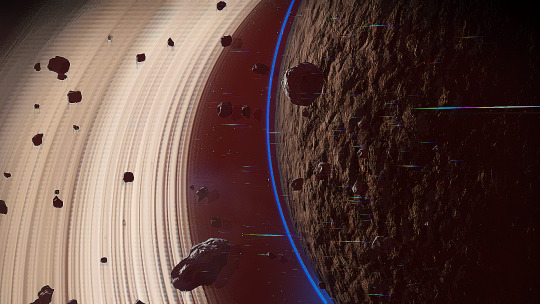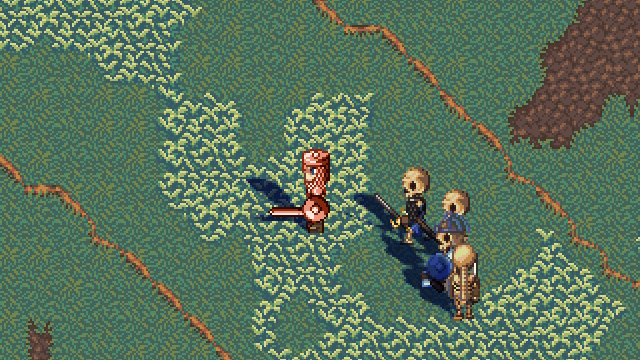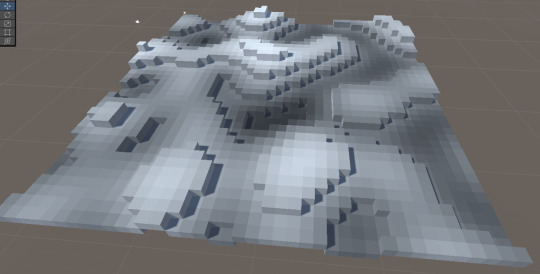#ProceduralGeneration
Explore tagged Tumblr posts
Text

Somewhere in the depths of the universe 🪐
#NoMansSky#GamingAesthetic#SpaceArt#ProceduralGeneration#CosmicBeauty#VirtualPhotography#OuterSpace#SciFiWorld#AsteroidField#RingedPlanet#GalacticVibes#DigitalArt#SpaceExploration#IndieGames#NoMansSkyArt
7 notes
·
View notes
Text
100 days of code - Round 2, day 2
Did which I didn't think it was interesting enough to post, but now I call it "aggro lines" and it's suddenly interesting! (made with p5.js)

2 notes
·
View notes
Text
From Manual to Machine-Made: The Evolution of Game Creation with AI

Game development used to be a slow, manual grind.. Developers wrote every mechanic out manually, artists labored painstakingly to create every asset, and months of playtesting were necessary to balance the gameplay. This process required massive teams, lots of time, and high prices.
Now, AI Game Development is revolutionizing all of it. It's no longer a fad — AI is radically transforming the way games are being made, making them smarter, quicker, and more customized. This revolution is particularly game-changing for independent developers and decentralized initiatives to be able to compete in a saturated and changing marketplace.
Why Game Dev Can't Ignore AI Anymore
Game developers' requirements continue to grow: the players demand smarter non-player characters, living worlds, and personalized gameplay experiences. At the same time, production budgets are low, and time-to-market is reducing.
AI Game Development resolves these issues by automating mundane tasks, lowering development costs, and facilitating scalable, adaptive design systems. It empowers teams to push the limits with less, and hence it is a must for indie studios as well as decentralized creators in order to keep up with growing demands and hold onto a competitive advantage.
The Manual Era of Game Development
Before AI, game development looked like this:
Scripting: Hand-coded each line of script for gameplay functionality and interaction, sometimes dedicating weeks to debugging and perfecting.
Asset Creation: Every model, texture, animation, and visual effect was hand-made by artists in a time-consuming, labor-intensive process.
Playtesting: Extended cycles of hand-testing were necessary for balancing gameplay, debugging, and testing for fun and fairness.
Big Teams and Budgets: The sheer amount of manual labor required large teams and big budgets.
For independent developers and decentralized game creators, these issues were amplified:
Tiny teams and lean budgets dragged out production.
Workflows that required manual effort hindered fast iteration and creativity.
Scaling content to accommodate increasing player bases was resource-dinted and expense-heavy.
The advent of AI Game Development brings about a change, eradicating many of these limitations and opening up new creative doors for small teams.
Enter AI: Smarter, Faster, More Scalable
AI Game Development is transforming old bottlenecks through automation and optimization of most core activities. For example, AI can generate 2D and 3D assets and animation automatically with minimal developer input, considerably cutting the time and effort needed for artwork creation.
It also facilitates dynamic procedural content creation, like levels, quests, and story aspects, so that games can present new and diversified experiences without human design for every aspect. Moreover, AI systems monitor player activity in real-time to balance game challenge and economies to keep the experience challenging and engaging. Adaptive AI-powered NPCs react individually to player behavior and styles to give a more immersive and personal experience.
Today's AI Game Development Platforms enable smaller teams to achieve in months what once took vast groups years, opening scalable, adaptive, and intelligence-evolving game worlds.
Why AI is Important for Indie Studios and Decentralized Game Projects
AI Game Development brings game-changing benefits to indie developers and decentralized projects:
Reduced Costs: Asset creation and testing automation via AI Game Development minimizes the need for big teams and massive outsourcing.
Faster Prototyping: AI Game Development quickens the design and iteration cycle, making it possible to validate rapidly new ideas and mechanics.
Scalable Worlds: Procedural content creation and AI-powered balancing with AI Game Development enable games to expand dynamically without substantial resource boosts.
Decentralized Creativity: AI Game Development supports the spirit of decentralized projects, making it possible to have intelligent, community-sourced ecosystems where games develop based on player feedback.
Key takeaways:
Shave overhead and shorten development cycles through AI Game Development.
Construct rich, scalable game worlds with small teams through AI-powered tools.
Facilitate player-led innovation in decentralized platforms driven by AI.
Empower independent developers to compete with major studios through the advantages of AI Game Development.
Why Choose an AI Game Development Company like GamesDApp
GamesDApp is a top AI Game Development Company that assists decentralized projects and indie studios in leveraging the complete potential of AI-enabled workflows. Through cutting-edge tools and services, such as AI-created assets and concept art services, GamesDApp empowers wiser, quicker, and more scalable game development for visionaries looking to innovate.
Final Thought
The transition from human to AI Game Development is transforming the way games are created — quicker development, expandable worlds, and genuinely customized player experiences. For independent studios and decentralized endeavors, it's the secret to creating better games with less.
An AI Game Development Company, such as GamesDApp, enables creators to catch up with current needs and redefine what's achievable in gaming. Adopting AI today translates to leading in an industry where innovation happens at a faster pace than ever before.
#AIGameDevelopment#GameDev#IndieGameDev#DecentralizedGaming#GamingInnovation#AIinGaming#GameDevelopmentTools#GamesDApp#FutureOfGaming#SmarterGameDesign#AIforIndieDevs#ProceduralGeneration#AdaptiveGameplay
0 notes
Text
Procedural Generation: Creating Infinite Worlds in Games
In the world of game development, one of the most exciting and innovative techniques is procedural generation. This technology allows developers to create vast, ever-expanding game worlds without manually designing every detail. With procedural generation, the possibilities are virtually endless, and it’s revolutionizing how developers approach world-building in games.

What is Procedural Generation?
Procedural generation refers to the use of algorithms and mathematical formulas to generate content—such as landscapes, levels, or even entire game worlds—dynamically, rather than relying on hand-crafted designs. It’s a method that has been embraced by a wide variety of games, from roguelikes to open-world adventures.
Benefits of Procedural Generation
Endless Replayability Games like Minecraft, No Man’s Sky, and Terraria have used procedural generation to create endless, ever-changing worlds that provide players with a new experience every time they play. This sense of infinite exploration is a massive draw for players.
Efficiency in Development Procedural generation saves time and resources by automating the creation of vast amounts of content. Developers no longer need to create every terrain, structure, or level manually, freeing up time to focus on other aspects of the game, like story, mechanics, and optimization.
Dynamic Content Procedural content adapts to player choices and behaviors, creating an experience that feels organic and responsive. Whether it’s the randomization of items, enemies, or landscapes, the game can continuously evolve and surprise the player, enhancing immersion.
Scalability With procedural generation, developers can easily scale the size of their worlds without worrying about excessive resource consumption. This means more expansive games can be created with fewer limitations on memory or storage.
How Does It Work?
Procedural generation works through algorithms that define how content is created. These algorithms often start with a seed—a random value that determines the initial parameters. From there, the algorithm generates content based on those parameters, such as creating terrain, placing objects, or populating the world with AI-driven entities.
In many cases, developers use Perlin noise or simplex noise to generate terrains and landscapes. These noise functions are used to create the random yet coherent appearance of natural environments, such as mountains, rivers, and forests.
Examples of Procedural Generation in Games
Minecraft: The iconic game that popularized procedural generation, allowing players to explore infinite worlds made up of blocks.
No Man’s Sky: Features a universe filled with millions of procedurally generated planets, each with its own ecosystem, animals, and resources.
Spelunky: A roguelike platformer that uses procedural generation to create new cave layouts each time the player starts a game.
Challenges of Procedural Generation
While procedural generation offers many benefits, it’s not without challenges. For instance, creating truly engaging and meaningful content using procedural algorithms can be difficult. Randomly generated environments can sometimes feel repetitive, bland, or unnatural if not carefully designed. Balancing randomness with structure is key to making procedural worlds that feel alive.
Procedural generation is a game-changer in game development, offering developers the ability to create vast, varied, and dynamic game worlds at scale. While it comes with challenges, the technology has led to innovative gaming experiences that keep players engaged with endless possibilities for exploration and discovery.
#ProceduralGeneration#GameWorlds#GameDevelopment#InfiniteWorlds#GameDesign#RandomContent#OpenWorldGames#GamingInnovation#ProceduralDesign#TechInGaming
1 note
·
View note
Text
Blog 41: Procedural Worldbuilding in Unreal Engine 5: A New Dawn for Environments
Procedural generation has long been the dream of environment designers: the ability to create vast, living worlds not by placing every rock by hand but by setting the rules and letting the world evolve naturally. In Unreal Engine 5, that dream became real with the launch of Procedural Content Generation (PCG).
PCG allows artists to define rules such as terrain types, vegetation spreads, and object density, and Unreal builds entire forests, cities, or landscapes automatically while still allowing manual fine-tuning. This massively increases creative freedom while saving production time.
For a project like Shambhala: The Ascension Protocol, this is a game-changer. Procedural tools mean that vast mystical temples, elemental Thantras, and floating islands can be generated with believable randomness, making the world feel alive, ancient, and natural rather than artificial.
Procedural workflows are not about replacing creativity. They enhance creativity. They let artists dream bigger, faster, and smarter.
youtube
I believe the future of environmental design lies in mastering these systems, blending the handcrafted emotional moments with the vastness that procedural generation can offer.
A world like Shambhala deserves to feel endless, and procedural generation helps us build that endlessness.
0 notes
Link
Untold Tales تعلن عن نسخة جديدة من EcoGnomix لأجهزة الكونسول كشفت شركة Untold Tales بالتعاون مع فريق التطوير Irox Games عن خططها لإطلاق لعبة EcoGnomix على أجهزة PlayStation وXbox، وذلك بعد إصدارها الناجح على الحاسب الشخصي وNintendo Switch أواخر العام الماضي. ورغم الإعلان الرسمي، لم يتم تحديد موعد دقيق لوصول اللعبة إلى المنصات الجديدة. تميزت EcoGnomix بأسلوب لعب مبتكر يمزج بين عناصر ألعاب بناء المدن وتعاقب الأدوار (RPG)، مما وفر تجربة
0 notes
Text
How Generative AI is Changing the Gaming Industry

The gaming industry is no stranger to technological innovation. From the earliest days of pixelated graphics to the immersive experiences offered by virtual reality, technology has continuously pushed the boundaries of what games can be. Today, one of the most exciting developments transforming the gaming landscape is generative AI. This powerful technology is revolutionizing how games are designed, developed, and played, opening up new possibilities for creativity, personalization, and player engagement.
In this blog post, we will explore how generative AI is changing the gaming industry, from procedural content generation and AI-driven narratives to adaptive gameplay and realistic NPCs (non-playable characters). We'll also discuss the potential benefits and challenges of integrating generative AI into game development. Join us as we delve into the fascinating world of generative AI and its impact on the future of gaming.
1. Procedural Content Generation
One of the most significant ways generative AI is transforming gaming is through procedural content generation (PCG). This technique uses algorithms to create game content dynamically, allowing developers to generate vast, intricate worlds, levels, and environments with minimal manual input. Popular games like "Minecraft" and "No Man's Sky" have successfully utilized PCG to create expansive, ever-changing landscapes that keep players engaged for hours.
Generative AI enhances PCG by creating more sophisticated and varied content, such as unique terrain features, complex dungeons, and realistic ecosystems. This not only saves time and resources for developers but also ensures that players have a fresh and unpredictable experience each time they play.
2. AI-Driven Narratives
Storytelling is a crucial element of many games, and generative AI is revolutionizing how narratives are crafted and delivered. Traditionally, game stories are scripted by writers, leading to linear and predetermined plots. With generative AI, game narratives can become more dynamic and responsive to player choices.
AI-driven narratives can adapt to individual player actions, creating personalized storylines that evolve based on decisions made throughout the game. This results in a more immersive and engaging experience, where players feel that their choices truly matter and shape the outcome of the story.
3. Adaptive Gameplay
Generative AI is also enhancing gameplay by making it more adaptive and responsive. AI algorithms can analyze player behavior and preferences in real-time, adjusting game difficulty, pacing, and challenges to match the player's skill level and style. This creates a more tailored and enjoyable experience, as the game evolves to meet the player's needs.
For example, if a player is struggling with a particular level or enemy, the AI can dynamically adjust the difficulty to provide a more balanced challenge. Conversely, if a player excels, the AI can introduce more complex obstacles and adversaries to keep the game engaging.
4. Realistic NPCs and Interactions
Non-playable characters (NPCs) are essential for creating rich and immersive game worlds. Generative AI is significantly improving the realism and behavior of NPCs, making them more lifelike and responsive. AI-driven NPCs can exhibit complex behaviors, emotions, and interactions, enhancing the overall gameplay experience.
With generative AI, NPCs can learn from player interactions, adapt their behavior, and provide more meaningful and dynamic responses. This leads to more realistic and engaging interactions, where NPCs feel like genuine characters rather than scripted entities.
5. Game Development Efficiency
Integrating generative AI into the game development process can significantly boost efficiency and creativity. AI algorithms can automate repetitive tasks, such as creating textures, generating levels, and designing characters, freeing up developers to focus on more complex and creative aspects of game design.
Generative AI can also assist in playtesting and quality assurance by simulating various player behaviors and identifying potential issues or areas for improvement. This accelerates the development cycle and helps ensure that the final product is polished and enjoyable.
Challenges and Considerations
While generative AI offers numerous benefits, its integration into game development also presents challenges. Ensuring that AI-generated content is coherent, balanced, and aligned with the game's vision requires careful oversight and fine-tuning. Additionally, ethical considerations, such as the potential for AI to perpetuate biases or create inappropriate content, must be addressed.
Conclusion
Generative AI is undeniably reshaping the gaming industry, offering unprecedented opportunities for innovation and creativity. From procedural content generation and adaptive gameplay to realistic NPCs and AI-driven narratives, this technology is enhancing every aspect of game design and player experience. As generative AI continues to evolve, we can expect even more groundbreaking advancements that will push the boundaries of what games can achieve.
The future of gaming is bright, and with generative AI at the helm, the possibilities are virtually limitless. Whether you're a developer, a gamer, or simply a technology enthusiast, the impact of generative AI on the gaming industry is something to watch closely. Stay tuned as we continue to explore the exciting developments in this dynamic and ever-evolving field.
#GenerativeAI#GamingIndustry#AIinGaming#GameDevelopment#ArtificialIntelligence#MachineLearning#GameDesign#TechInnovation#InteractiveEntertainment#AI#FutureOfGaming#GameTech#ProceduralGeneration#ImmersiveGames#TechTrends
0 notes
Text
instagram
I wanted to do a small seva to " Prabhu Shree Ram " via Coding for Jan 22nd Ayodhya Ram Mandir " Prana Prathisthapane ".
I have written a small program to animate particles.
Note : Sound ON (Headphones or Earphones are recommended)
#coding#art#creativecoding#ayodhyarammandir🚩#lordhanuman#lordrama#lordram#rama#particles#particlesystem#steeringbehaviors#pixelart#ayodhya#jaishreeram#proceduralgeneration#proceduralart#p5jsart#p5js#p5jsgenerativeart#generativeart#processing#programming#java#physics#acceleration#velocity#pvector#vector#digitalart#digitalartwork
0 notes
Text
#Gaming#AIinVideoGames#EpicGames#Valve#GameDevelopment#IntellectualProperty#BlockchainGaming#CopyrightIssues#InnovationInGaming#LegalChallenges#FutureOfGaming#AIinEntertainment#GamingControversy#DigitalGameStores#NFTsInGaming#GameAI#ProceduralGeneration#GamingCommunity#USCopyrightOffice#EthicalAI
0 notes
Text

New chonky damage numbers for my game Shards of Ascension!
#pixel art#ShardsOfAscension#pixelart#gameart#ドット絵#madewithunity#unity3d#gamedev#indiedev#indiegamedev#rpg#indiegaming#indiewatch#proceduralgeneration#procgen
2 notes
·
View notes
Photo

Art by @tylerxhobbs A few of the "super dense" Fidenzas that max out the visual noise level. They can be overwhelming at first, but they have their own charm if you sit with them. #Fidenza #artblocks #cryptoart #cryptoartwork #cryptoartist #nft #nftart #nftartist #nftartistsoninstagram #generative #atxartist #texasartist #muralist #generativeart #proceduralgeneration #proceduralart #programming #processing #algorithmicart #creativecoding #creativecodeart https://www.instagram.com/p/ClUEFrpr86j/?igshid=NGJjMDIxMWI=
#fidenza#artblocks#cryptoart#cryptoartwork#cryptoartist#nft#nftart#nftartist#nftartistsoninstagram#generative#atxartist#texasartist#muralist#generativeart#proceduralgeneration#proceduralart#programming#processing#algorithmicart#creativecoding#creativecodeart
1 note
·
View note
Text
100 days of code - Round 2, day 3
Made a minecrafty-like terrain with perlin noise in Unity.

Integrated a grayscale from the height. Introducing:
Perlin noise
Material Property Blocks
Special thanks to my spouse for helping me😍
I wasn't able to upload the gif to tumblr, so here is it
Tutorial from
0 notes
Video
instagram
Third day at the #notchvfx workshop I learned about #proceduralgeneration and combining it with cloners. What a lovely technique! . #madewithnotch #realtime #realtimerendering #newmediaart #generativeart #xuxoe #mdcommunity #motiongraphics #motiondesign #3dart #3d #3dartist #digitalart #cgi #cgiart #cgsociety #glitch #visualcreators (at Montreal, Quebec) https://www.instagram.com/p/B5V2NpAHq47/?igshid=yxhqmg76i2ya
#notchvfx#proceduralgeneration#madewithnotch#realtime#realtimerendering#newmediaart#generativeart#xuxoe#mdcommunity#motiongraphics#motiondesign#3dart#3d#3dartist#digitalart#cgi#cgiart#cgsociety#glitch#visualcreators
4 notes
·
View notes
Photo

Nuclear manipulation!
Steam:https://store.steampowered.com/app/1177950
1 note
·
View note
Video
instagram
#Gaia #procedural #generation #ProceduralGeneration #postprocessing #3D #environment #Unity #unity3D #game #engine #development #indie #bigglesworthstudios 🐰 https://www.instagram.com/p/B0JZc1FBUH9gA8c1eNu6bTq7uCu4Wywg1PnfZk0/?igshid=14w3rh0l7vgxw
#gaia#procedural#generation#proceduralgeneration#postprocessing#3d#environment#unity#unity3d#game#engine#development#indie#bigglesworthstudios
1 note
·
View note
Photo

👾 Random GEN PFPs 👾 - 3,696 GENs dropped to @wilder.world, each one 100% unique in form, procedurally generated with @sidefxhoudini and metaverse-ready with @unrealengine. Don’t miss the next GENeration of asset creation! - 👁️ See the collection: https://opensea.io/collection/wilderpals-gen - 📺 See GENs Trailer: https://youtube.com/watch?v=SnFPK5nlR2Q - ✅ Join the discord: https://discord.gg/wilderworld - 🧬 GENs made by: @olegsoroko.eth & @ekimroyrp . . . . . . #wilderworld #generativedesign #digitalart #proceduralgeneration #procedural #mmorpg #sidefx #sidefxhoudini #gamedesign #videogames #sketchfab #parametricdesign #unrealengine #scifi #grasshopper3d #generativeart #superarchitects #3dmodel #nextarch #characterdesign #computationaldesign #proceduralart #generativeart #parametricarchitecture #next_top_architects #scifiart #3dmodeling #UE5 #metaverse #houdini (at The Metaverse) https://www.instagram.com/p/CqQnt6uvJE0/?igshid=NGJjMDIxMWI=
#wilderworld#generativedesign#digitalart#proceduralgeneration#procedural#mmorpg#sidefx#sidefxhoudini#gamedesign#videogames#sketchfab#parametricdesign#unrealengine#scifi#grasshopper3d#generativeart#superarchitects#3dmodel#nextarch#characterdesign#computationaldesign#proceduralart#parametricarchitecture#next_top_architects#scifiart#3dmodeling#ue5#metaverse#houdini
0 notes